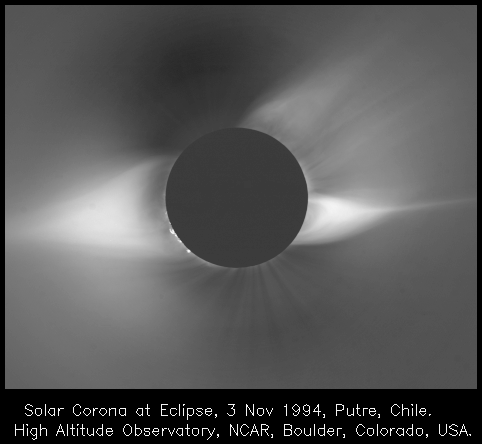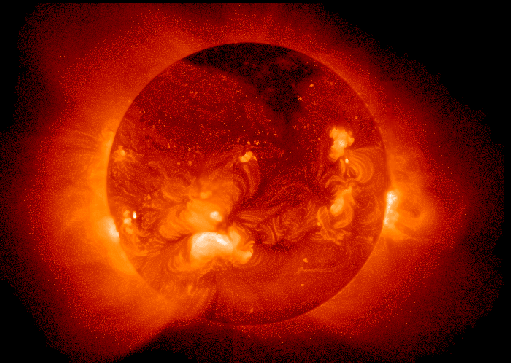The Corona
 The outermost layer of the Sun
is called the corona or the crown. The corona is very
thin and faint and is therefore very difficult to observe from the earth.
Typically, we observe the corona during a total solar eclipse or by using
a coronagraph telescope which simulates an eclipse by covering the bright
solar disk.
The outermost layer of the Sun
is called the corona or the crown. The corona is very
thin and faint and is therefore very difficult to observe from the earth.
Typically, we observe the corona during a total solar eclipse or by using
a coronagraph telescope which simulates an eclipse by covering the bright
solar disk.
The corona also emits energy of many different wavelengths, from long
wavelength radio waves, to short wavelength X-rays. By designing special
telescopes we are able to look at the corona in many different ways.
Below is a picture of X-rays coming from our Sun taken by an X-ray
telescope on the Yohkoh satellite currently orbiting the earth.
 The X-rays we see all come from the corona, the outermost layer of the
Sun's atmosphere. But not all the corona emits the same amount of
X-rays.
The most visible structures are the loops and
arches around the active regions. We may
also see much smaller regions called "bright points." (The name gives
away their appearance.) Movies made from X-ray pictures show that the
corona is a very stormy place, constantly changing and erupting. In X-ray
images we may also see areas called "coronal
holes," regions of low brightness at the north and south poles.
The X-rays we see all come from the corona, the outermost layer of the
Sun's atmosphere. But not all the corona emits the same amount of
X-rays.
The most visible structures are the loops and
arches around the active regions. We may
also see much smaller regions called "bright points." (The name gives
away their appearance.) Movies made from X-ray pictures show that the
corona is a very stormy place, constantly changing and erupting. In X-ray
images we may also see areas called "coronal
holes," regions of low brightness at the north and south poles.

Image Credits:
Solar Eclipse: HAO/NCAR
X-Ray Sun: Yohkoh Science Team
 The outermost layer of the Sun
is called the corona or the crown. The corona is very
thin and faint and is therefore very difficult to observe from the earth.
Typically, we observe the corona during a total solar eclipse or by using
a coronagraph telescope which simulates an eclipse by covering the bright
solar disk.
The outermost layer of the Sun
is called the corona or the crown. The corona is very
thin and faint and is therefore very difficult to observe from the earth.
Typically, we observe the corona during a total solar eclipse or by using
a coronagraph telescope which simulates an eclipse by covering the bright
solar disk. 